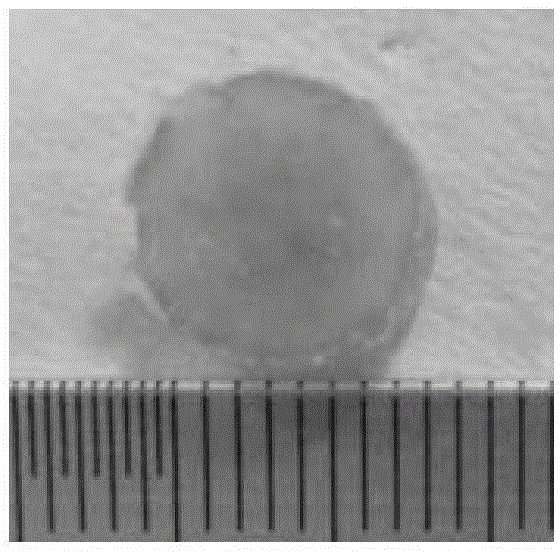Method for preparing xerogel fixed ligand polymer micro-extraction membrane device
A technology of coordination polymers and extraction membranes, applied in the preparation of test samples, ion exchange treatment devices, chemical/physical processes, etc., can solve the problems of poor experimental accuracy and reproducibility, adsorbent leakage, and material bag rupture and other problems, to achieve the effect of shortening the experiment time, manpower and material resources, less cost, and good thermal stability
- Summary
- Abstract
- Description
- Claims
- Application Information
AI Technical Summary
Problems solved by technology
Method used
Image
Examples
Embodiment 1
[0022] Example 1: immobilization of polymer Co 3 (C 9 h 6 o 6 )·12H 2 0 xerogel microextraction membrane
[0023] A. Weigh 2.0 mg of polymer Co 3 (C 9 h 6 o 6 )·12H 2Add 0 material into a 1.5ml microcentrifuge tube, then add 100μl of N,N-dimethylformamide (DMF) solution and 50μl of ultrapure water to it, and sonicate for 30min;
[0024] B. After the sonication is over, take out the centrifuge tube and add 350 μl of tetraethoxysilane (TEOS) and 50 μl of hydroxyl-terminated polydimethylsiloxane (PDMS) to the mixed solution, and continue to sonicate for 120 minutes;
[0025] C. After step B, take out the centrifuge tube again, shake it up and down to make it evenly mixed; open the cap of the tube, add 70 μl of trifluoroacetic acid (TFA) catalyst into it, cover the cap and shake it up and down, let it react for 5 minutes;
[0026] D. After 5 minutes, use a sampling tube to absorb the sol solution, and place it on the cap of a 10ml centrifuge tube as a substrate. Open th...
Embodiment 2
[0029] Embodiment 2: Immobilization of polymer Zn 3 (C 8 h 8 o 4 ) xerogel microextraction membrane
[0030] A. Weigh 2.0mg of polymer Zn 3 (C 8 h 8 o 4 ) material into a 1.5ml microcentrifuge tube, then add 100μl of N,N-dimethylformamide (DMF) solution and 50μl of ultrapure water to it, and sonicate for 30min;
[0031] B. After the sonication is over, take out the centrifuge tube and add 350 μl of tetraethoxysilane (TEOS) and 50 μl of hydroxyl-terminated polydimethylsiloxane (PDMS) to the mixed solution, and continue to sonicate for 120 minutes;
[0032] C. After step B, take out the centrifuge tube again, shake it up and down to make it evenly mixed; open the cap of the tube, add 70 μl of trifluoroacetic acid (TFA) catalyst into it, cover the cap and shake it up and down, let it react for 5 minutes;
[0033] D. After 5 minutes, use a sampling tube to absorb the sol solution, and place it on the cap of a 10ml centrifuge tube as a substrate. Open the fume hood to age ...
Embodiment 3
[0036] Embodiment 3: fixed polymer Cu(C 9 h 6 o 6 )(C 3 h 7 NO) xerogel microextraction membrane
[0037] A. Weigh 2.0 mg of polymer Cu(C 9 h 6 o 6 )(C 3 h 7 NO) material was added to a 1.5ml microcentrifuge tube, then 100μl of N,N-dimethylformamide (DMF) solution and 50μl of ultrapure water were added to it, and ultrasonicated for 30min;
[0038] B. After the sonication is over, take out the centrifuge tube and add 350 μl of tetraethoxysilane (TEOS) and 50 μl of hydroxyl-terminated polydimethylsiloxane (PDMS) to the mixed solution, and continue to sonicate for 120 minutes;
[0039] C. After step B, take out the centrifuge tube again, shake it up and down to make it evenly mixed; open the cap of the tube, add 70 μl of trifluoroacetic acid (TFA) catalyst into it, cover the cap and shake it up and down, let it react for 5 minutes;
[0040] D. After 5 minutes, use a sampling tube to absorb the sol solution, and place it on the cap of a 10ml centrifuge tube as a substrat...
PUM
| Property | Measurement | Unit |
|---|---|---|
| diameter | aaaaa | aaaaa |
Abstract
Description
Claims
Application Information
 Login to View More
Login to View More - R&D
- Intellectual Property
- Life Sciences
- Materials
- Tech Scout
- Unparalleled Data Quality
- Higher Quality Content
- 60% Fewer Hallucinations
Browse by: Latest US Patents, China's latest patents, Technical Efficacy Thesaurus, Application Domain, Technology Topic, Popular Technical Reports.
© 2025 PatSnap. All rights reserved.Legal|Privacy policy|Modern Slavery Act Transparency Statement|Sitemap|About US| Contact US: help@patsnap.com



